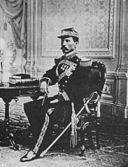Relocation Period (>1887)
|
President Diaz Source - http://commons.wikimedia.org/wiki/File:Young_Porfirio_Diaz.jpg General Diaz, considered to be a dictator by many, became President of Mexico after defeating incumbent government forces. In order to gain control of the fertile lands in Yaqui territory, Diaz initiated a brutal campaign of ethnic cleansing. A bounty was placed on the heads of Yaqui warriors, and all others that did not manage to hide or escape were deported. After enduring long, forced marches they were sent to concentrations camps and sold as slaves to plantations and mines located in distant areas of Mexico. By the turn of the century, nearly all the Yaqui towns were deserted. To avoid capture and deportation, many Yaqui went into hiding and thousands of others made the long 400 mile walk northward to seek asylum in the United States. By the end of Diaz's regime, the Yaqui population had been reduced from some 20,000 people to less than 3,000. Yaqui slavery was ended in 1911 by the Mexican Revolution, but this revolution also ended with the loss of their lands. They would not regain their lands until 1939, when the Mexican government set aside a small portion of their original territory for their use. Most of the Yaquis that had fled to Arizona elected to stay there. Today, some 6,000 descendants of these immigrants live in southern Arizona in neighborhoods within or near the cities of Phoenix, Tucson, and Yuma. In 1978, the United States government officially granted them tribal recognition status and awarded them a small reservation within the city boundaries of Tucson. Most of the American Yaqui live in one of six communities, or barrios, within urban settings. These barrios retain the church-centered layout and ideology that crystallized during the Mission Period more than two centuries ago, and their inhabitants continue to follow the syncretic Catholic and native religion established during that time. |
Click on next page to continue.

